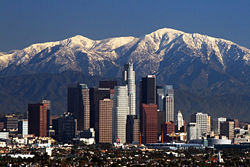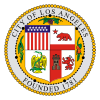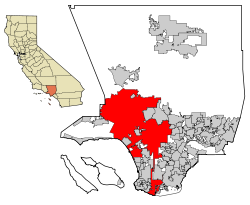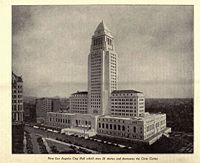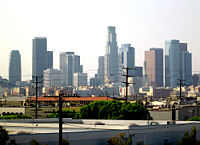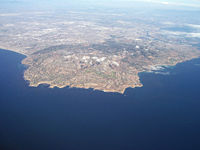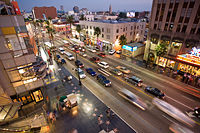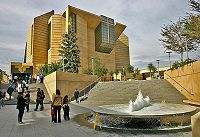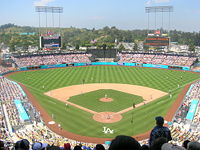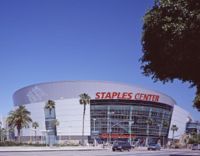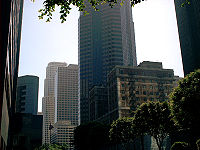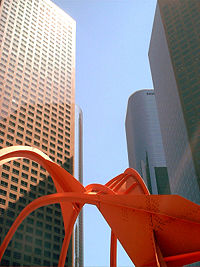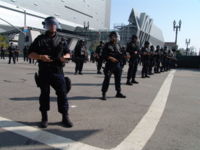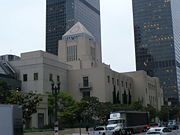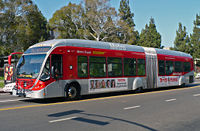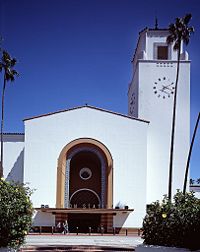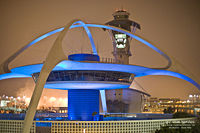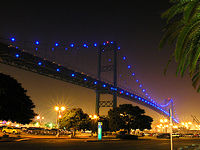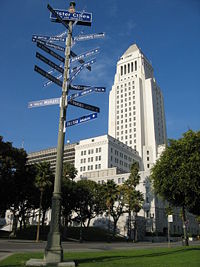Los Angeles, California
2008/9 Schools Wikipedia Selection. Related subjects: Cities; North America
| City of Los Angeles | |||
| The Los Angeles skyline in December 2007 | |||
|
|||
| Nickname(s): L.A., The City of Angels | |||
| Location within Los Angeles County in the state of California | |||
| Coordinates: | |||
|---|---|---|---|
| State | California | ||
| County | Los Angeles County | ||
| Settled | September 4, 1781 | ||
| Incorporated | April 4, 1850 | ||
| Government | |||
| - Type | Mayor-Council | ||
| - Mayor | Antonio Villaraigosa | ||
| - City attorney | Rocky Delgadillo | ||
| - Governing body | City Council | ||
| Area | |||
| - City | 498.3 sq mi (1,290.6 km²) | ||
| - Land | 469.1 sq mi (1,214.9 km²) | ||
| - Water | 29.2 sq mi (75.7 km²) 5.8% | ||
| - Urban | 1,667.9 sq mi (4,319.9 km²) | ||
| Elevation | 233 (city hall) ft (71 m) | ||
| Population (2006) | |||
| - City | 3,849,378 ( 2nd U.S., 45th World) | ||
| - Density | 8,205/sq mi (3,168/km²) | ||
| - Metro | 12,875,587 | ||
| - Demonym | Angeleno | ||
| Time zone | PST ( UTC-8) | ||
| - Summer ( DST) | PDT ( UTC-7) | ||
| ZIP code | 90001-90068, 90070-90084, 90086-90089, 90091, 90093-90097, 90099, 90101-90103, 90174, 90185, 90189 | ||
| Area code(s) | 213, 310, 323, 424, 661, 818 | ||
| Website: www.lacity.org | |||
Los Angeles (IPA: /lɑˈsændʒələs/, IPA: /los ˈaŋxeles/ in Spanish) is the largest city in the state of California and the second largest in the United States. Often abbreviated as L.A. and nicknamed The City of Angels, it is rated an alpha world city, having an estimated population of 3.8 million and spanning over 498.3 square miles (1,290.6 km²) in Southern California. Additionally, the Los Angeles metropolitan area is home to nearly 12.9 million people who hail from all over the globe and speak 224 different languages. Los Angeles is the seat of Los Angeles County, the most populous and one of the most diverse counties in the United States. Its inhabitants are known as "Angelenos" (IPA: /ændʒəˈlinoʊz/).
Los Angeles was founded in 1781, by Spanish governor Felipe de Neve as El Pueblo de Nuestra Señora la Reina de los Ángeles de Porciúncula (The Village of Our Lady, the Queen of the Angels of Porziuncola). It became a part of Mexico in 1821, following its independence from Spain. In 1848, at the end of the Mexican-American War, Los Angeles and California were purchased as part of the Treaty of Guadalupe Hidalgo, thus becoming part of the United States; Mexico retained the territory of Baja California. It was incorporated as a municipality on April 4, 1850 — five months before California achieved statehood.
Los Angeles is one of the world's centers of culture, technology, media, business, and international trade. It is home to renowned institutions covering a broad range of professional and cultural fields, and it is one of the most substantial economic engines within the United States. Los Angeles also leads the world in producing popular entertainment — such as motion picture, television, internet content, video games and recorded music — which forms the base of its international fame and global status.
History
The Los Angeles coastal area was first settled by the Tongva (or Gabrieleños) and Chumash Native American tribes hundreds of years ago. The first Europeans arrived in 1542 under João Cabrilho, a Portuguese explorer who claimed the area as the City of God for the Spanish Empire; he continued with his voyage and did not establish a settlement. The next contact would not come until 227 years later, when Gaspar de Portola, along with Franciscan missionary Juan Crespí, reached the present site of Los Angeles on August 2, 1769. Crespi noted that the site had the potential to be developed into a large settlement.
In 1771, Franciscan friar Junípero Serra built the Mission San Gabriel Arcangel near Whittier Narrows, in what is now called San Gabriel Valley. In 1777, the new governor of California, Felipe de Neve, recommended to the viceroy of New Spain that the site noted by Juan Crespi be developed into a pueblo. The town was founded on September 4, 1781, by a group of 44 settlers and was named "El Pueblo de Nuestra Señora la Reina de los ángeles Del Río de Porciúncula" ("The Town of Our Lady the Queen of the Angels on the River Porciúncula"). These settlers were of Filipino, Native American, African, and Spanish ancestry, with two-thirds being mestizo or mulatto. A majority of the settlers had some African ancestry. The settlement remained a small ranch town for decades, but by 1820 the population had increased to about 650 residents. Today, the pueblo is commemorated in the historic district Olvera Street, the oldest part of Los Angeles.
New Spain achieved its independence from the Spanish Empire in 1821, and the pueblo continued as a part of Mexico. Mexican rule ended during the Mexican-American War: Americans took control from the Californios after a series of battles, culminating on January 13, 1847, with the signing of the Treaty of Cahuenga. Later, with the Treaty of Guadalupe Hidalgo in 1848, the Mexican government formally ceded Alta California and other territories to the United States.
Railroads arrived when the Southern Pacific completed its line to Los Angeles in 1876. Oil was discovered in 1892, and by 1923 Los Angeles was producing one-quarter of the world's petroleum.
By 1900, the population had grown to more than 102,000 people, putting pressure on the city's water supply. 1913's completion of the Los Angeles Aqueduct, under the supervision of William Mulholland, assured the continued growth of the city. In 1915, Los Angeles began the annexation of dozens of neighboring communities without water supplies of their own.
In the 1920s, the motion picture and aviation industries flocked to Los Angeles. In 1932, with population surpassing one million, the city hosted the Summer Olympics. This period also saw the arrival of exiles from the increasing pre-war tensions of Europe, including Thomas Mann, Fritz Lang, Bertolt Brecht, Arnold Schoenberg, and Lion Feuchtwanger.
World War II and the expansion of defense industries brought new growth and prosperity to the city. Thousands of African Americans migrated from Texas, Louisiana, and Mississippi to work in these expanding fields. The state also succumbed to war fears, transporting most Japanese American residents from Los Angeles and other cities to distant internment camps for the duration of the war.
The post-war years saw an even greater boom, as urban sprawl expanded the city into the San Fernando Valley. In 1969, Los Angeles became one of the birthplaces of the Internet, as the first ARPANET transmission was sent from UCLA to SRI in Menlo Park.
Also in the 1980s, Los Angeles became the centre of the heavy metal music scene, especially glam metal bands. In 1984, the city hosted the Summer Olympic Games for the second time. It became the most financially successful Olympics in history, and only the second Olympics to turn a profit — the other being the 1932 Summer Olympics, also held in Los Angeles.
During the remainder of the 1980s, Los Angeles was plagued by increasing gang violence and police corruption. Racial tensions erupted again in 1992 with the Rodney King controversy and the large-scale riots that followed the acquittal of his police attackers. In 1994, the 6.7 Northridge earthquake shook the city, causing $12.5 billion in damage and 72 deaths.
Voters defeated efforts by the San Fernando Valley and Hollywood to secede from the city in 2002.
Gentrification and urban redevelopment have occurred in many parts of the city, most notably Hollywood, Koreatown, Silver Lake, Echo Park and Downtown. Gentrification has recently spilled into the eastern and southern portions of Los Angeles, with announcements of several billion-dollar residential high-rise and commercial centre projects.
Geography
Topography
Los Angeles is irregularly shaped and covers a total area of 498.3 square miles (1,291 km²), comprising 469.1 square miles (1,214.9 km²) of land and 29.2 square miles (75.7 km²) of water. The city extends for 44 miles (71 km) longitudinally and for 29 miles (47 km) latitudinally. The perimeter of the city is 342 miles (550 km). It is the only major city in the United States bisected by a mountain range.
The highest point in Los Angeles is Mount Lukens, also called Sister Elsie Peak. Located at the far reaches of the northeastern San Fernando Valley, it reaches a height of 5,080 ft (1,548 m). The major river is the Los Angeles River, which begins in the Canoga Park district of the city and is largely seasonal. The river is lined in concrete for almost its entire length as it flows through the city into nearby Vernon on its way to the Pacific Ocean.
Geology
Los Angeles is subject to earthquakes due to its location in the Pacific Ring of Fire. The geologic instability produces numerous fault lines both above and below ground, which altogether cause approximately 10,000 earthquakes every year. One of the major fault lines is the San Andreas Fault. Located at the boundary between the Pacific Plate and the North American Plate, it is predicted to be the source of Southern California's next big earthquake. Major earthquakes to have hit the Los Angeles area include the 2008 Chino Hills earthquake, 1994 Northridge earthquake, the 1987 Whittier Narrows earthquake, the 1971 San Fernando earthquake near Sylmar, and the 1933 Long Beach earthquake. Nevertheless, all but a few quakes are of low intensity and are not felt. The most recent earthquake felt was the 5.4 Chino Hills earthquake on July 29th 2008. Parts of the city are also vulnerable to Pacific Ocean tsunamis; harbour areas were damaged by waves from the Valdivia earthquake in 1960.
The Los Angeles basin and metropolitan area are also at risk from blind thrust earthquakes .
Climate
Los Angeles has Mediterranean climate or Dry-Summer subtropical zone ( Köppen climate classification Csb on the coast, Csa inland). The city experiences 325 sunny days every year with dry, warm to hot summers and cool to mild, somewhat rainy winters with low humidity year-round.
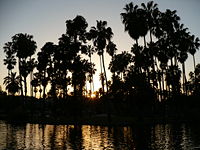
The prevalent warm southerly airflow and the blocking effect of mountains to the north give the city a much warmer climate than certain inland locations located at the same latitude. Breezes from the Pacific Ocean tend to keep the beach communities of the Los Angeles area cooler in summer and warmer in winter than those further inland; summer temperatures can sometimes be as much as 18°F (10°C) warmer in the inland communities compared to that of the coastal communities.
Summers average high temperatures in the Downtown area with highs around 81 - 84°F (27 - 29°C) and lows of 63°F (16°C), and winter high temperatures of 65 - 68°F (18 - 20°C) and lows of 48 - 50°F (8 - 10°C). During this season, rain is common. Temperatures can sometimes exceed 90°F (32°C) during the summer.
Rain occurs mainly in the winter and spring months (February being the wettest month), with light rainfall, sometimes as thunderstorms. Los Angeles averages 15 inches (385 mm) of precipitation per year. Tornados are extraordinarily rare downtown, though waterspouts can be seen during severe storms at beaches. Snow is extraordinarily rare in the city basin, but the mountainous slopes within city limits typically receive snow every year. The greatest snowfall recorded in downtown Los Angeles was 2.0 inches (5 cm) on January 15, 1932.
| Weather averages for Los Angeles, California (downtown) | |||||||||||||
|---|---|---|---|---|---|---|---|---|---|---|---|---|---|
| Month | Jan | Feb | Mar | Apr | May | Jun | Jul | Aug | Sep | Oct | Nov | Dec | Year |
| Record high °F (°C) | 90 (32) | 92 (33) | 93 (33) | 96 (35) | 99 (37) | 104 (40) | 103 (39) | 102 (39) | 110 (43) | 104 (40) | 96 (35) | 92 (33) | 110 (43) |
| Average high °F (°C) | 65 (18) | 66 (18) | 68 (20) | 70 (21) | 73 (22) | 76 (24) | 84 (29) | 82 (27) | 81 (27) | 77 (25) | 73 (22) | 68 (20) | 73 (22) |
| Average low °F (°C) | 48 (8) | 49 (9) | 50 (10) | 53 (11) | 56 (13) | 58 (14) | 63 (16) | 63 (17) | 61 (16) | 58 (14) | 53 (11) | 50 (10) | 55 (12) |
| Record low °F (°C) | 28 (-2) | 34 (1) | 38 (3) | 41 (5) | 43 (6) | 50 (10) | 54 (12) | 51 (10) | 50 (10) | 46 (8) | 40 (4) | 30 (-1) | 28 (-2) |
| Precipitation inches (cm) | 2.7 (6) | 3.1 (7) | 2.2 (5) | 1.3 (3.3) | 0.3 (0.8) | 0.1 (0.2) | 0 (0) | 0 (0) | 0.2 (0.5) | 0.4 (1) | 1.1 (2) | 2.5 (6) | 14 (35) |
| Source: weatherbase.com Jun 2007 | |||||||||||||
Flora
The Los Angeles area is rich in native plant species due in part to a diversity in habitats, including beaches, wetlands, and mountains. The most prevalent botanical environment is coastal sage scrub, which covers the hillsides in combustible chaparral. Native plants include: California poppy, matilija poppy, toyon, Coast Live Oak, and giant wild rye grass. Many of these native species, such as the Los Angeles sunflower, have become so rare as to be considered endangered. Though they are not native to the area, the official tree of Los Angeles is the tropical Coral Tree and the official flower of Los Angeles is the Bird of Paradise, Strelitzia reginae.
Environmental issues

Owing to geography, heavy reliance on automobiles, and the Los Angeles/Long Beach port complex, Los Angeles suffers from air pollution in the form of smog. The Los Angeles Basin and the San Fernando Valley are susceptible to atmospheric inversion, which holds in the exhausts from road vehicles, airplanes, locomotives, shipping, manufacturing, and other sources. Unlike other large cities that rely on rain to clear smog, Los Angeles gets only 15 inches (381 mm) of rain each year: pollution accumulates over many consecutive days. Issues of air quality in Los Angeles and other major cities led to the passage of early national environmental legislation, including the Clean Air Act. More recently, the state of California has led the nation in working to limit pollution by mandating low emission vehicles.
As a result, pollution levels have dropped in recent decades. The number of Stage 1 smog alerts has declined from over 100 per year in the 1970s to almost zero in the new millennium. Despite improvement, the 2006 annual report of the American Lung Association ranks the city as the most polluted in the country with short-term particle pollution and year-round particle pollution. In addition, the groundwater is increasingly threatened by MTBE from gas stations and perchlorate from rocket fuel. With pollution still a significant problem, the city continues to take aggressive steps to improve air and water conditions.
Cityscape
The city is divided into many neighborhoods, many of which were towns that were annexed by the growing city. There are also several independent cities in and around Los Angeles, but they are popularly grouped with the city of Los Angeles, either due to being completely engulfed as enclaves by Los Angeles, or lying within its immediate vicinity. Generally, the city is divided into the following areas: Downtown Los Angeles, Northeast - including Highland Park and Eagle Rock areas, the Eastside, South Los Angeles (still often colloquially referred to as South Central by locals), the Harbour Area, Hollywood, Wilshire, the Westside, and the San Fernando and Crescenta Valleys.
Some well-known communities of Los Angeles include West Adams, Watts, Venice Beach, the Downtown Financial District, Los Feliz, Silver Lake, Hollywood, Koreatown, Westwood and the more affluent areas of Bel Air, Benedict Canyon, Hollywood Hills, Hancock Park, Pacific Palisades, and Brentwood.
Landmarks
Important landmarks in Los Angeles include Chinatown, Koreatown, Little Tokyo, Walt Disney Concert Hall, Kodak Theatre, Griffith Observatory, Getty Centre, Los Angeles Memorial Coliseum, Los Angeles County Museum of Art, Grauman's Chinese Theatre, Hollywood Sign, Hollywood Boulevard, Capitol Records Tower, Los Angeles City Hall, Hollywood Bowl, Watts Towers, Staples Centre, Dodger Stadium and La Placita Olvera/ Olvera Street.
Culture
The people of Los Angeles are known as Angelenos. Nighttime hot spots include places such as Downtown Los Angeles, Silver Lake, Hollywood, and West Hollywood, which is the home of the world-famous Sunset Strip.
Some well-known shopping areas are the Hollywood and Highland complex, the Beverly Center, Melrose Avenue, Robertson Boulevard, Rodeo Drive, 3rd St. Promenade in Santa Monica, The Grove, Westside Pavilion, The Promenade at Howard Hughes Centre and Venice Boardwalk.
Religion
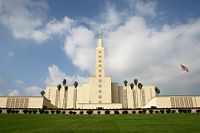
The Roman Catholic Archbishop of Los Angeles leads the largest archdiocese in the country. Roger Cardinal Mahony oversaw construction of the Cathedral of Our Lady of the Angels, completed in 2002 at the north end of downtown. Construction of the cathedral marked a coming of age of the Catholic, heavily Latino community. There are numerous Catholic churches and parishes throughout the city.
The Los Angeles California Temple, the second largest temple operated by The Church of Jesus Christ of Latter-day Saints, is on Santa Monica Boulevard in the Westwood district of Los Angeles. Dedicated in 1956, it was the first Mormon temple built in California and it was the largest in the world when completed. The grounds includes a visitors' centre open to the public, the Los Angeles Regional Family History Centre, also open to the public, and the headquarters for the Los Angeles mission.
With 621,000 Jews in the metropolitan area (490,000 in city proper), the region has the second largest population of Jews in the United States. Many synagogues of the Reform, Conservative, Orthodox, and Reconstructionist movements can be found throughout the city. Most are located in the San Fernando Valley and West Los Angeles. The area in West Los Angeles around Fairfax and Pico Boulevards contains a large number of Orthodox Jews. The Breed Street Shul in East Los Angeles, built in 1923, was the largest synagogue west of Chicago in its early decades. (It is no longer a sacred space and is being converted to a museum and community centre.) The Kabbalah Centre, devoted to one line of Jewish mysticism, is also in the city.
Because of Los Angeles' large multi-ethnic population, a wide variety of faiths are practiced, including Islam, Buddhism, Hinduism, Zoroastrianism, Sikhism, Bahá'í, various Eastern Orthodox Churches, Sufism and others. Immigrants from Asia for example, have formed a number of significant Buddhist congregations making the city home to the greatest variety of Buddhists in the world. Los Angeles currently has the largest Buddhist population in the United States. There are more than 300 Buddhist temples in Los Angeles.
The Church of Scientology has had a presence in Los Angeles since it opened February 18, 1954. It has several churches and museums in the area, most notably the Celebrity Centre in Hollywood.
Sports
Los Angeles is the home of the Los Angeles Dodgers of Major League Baseball, the Los Angeles Kings of the National Hockey League, the Los Angeles Clippers and Los Angeles Lakers of the National Basketball Association, the Los Angeles Sparks of the WNBA, the Los Angeles Riptide of Major League Lacrosse, and the Los Angeles Avengers of the Arena Football League. Los Angeles is also home to the USC Trojans and the UCLA Bruins in the NCAA, both of which are Division I teams in the Pacific-10 Conference. UCLA has more NCAA national championships, all sports combined, than any other university in America. USC has the third most NCAA national championships, all sports combined, in the United States. Several more teams are in the greater Los Angeles media market: the Los Angeles Angels of Anaheim of Major League Baseball and the Anaheim Ducks of the National Hockey League are both based in nearby Anaheim; and the Los Angeles Galaxy and Club Deportivo Chivas USA of Major League Soccer are both based in neighboring Carson.
There was a time when the Los Angeles media market boasted two NFL teams, the Rams and the Raiders. Both left the media market in 1995, with the Rams moving to St. Louis and the Raiders heading back to Oakland. Through the 2007-08 season there is no NFL franchise in the Los Angeles market, which is the second-largest city and television market in the United States. Prior to 1995, the Rams called Memorial Coliseum (1946-1979) and Anaheim Stadium (1980-1994) home; and the Raiders played their home games at Memorial Coliseum from 1982 to 1994.
Since the franchise's departures the NFL as an organization, and individual NFL owners, have attempted to relocate a team to the city. Immediately following the 1995 NFL season, Seattle Seahawks owner Ken Behring went as far as packing up moving vans to start play in the Rose Bowl under a new team name and logo for the 1996 season. The State of Washington filed a law suit to successfully prevent the move. In 2003, then NFL Commissioner Paul Tagliabue indicated L.A. would get a new expansion team, a thirty-third franchise, after the choice of Houston over L.A. in the 2002 league expansion round. When the New Orleans Saints were displaced from the Superdome by Hurricane Katrina media outlets reported the NFL was planning to move the team to Los Angeles permanently. Despite these efforts, and the failure to build a new stadium for an NFL team, L.A. is still expected to return to the league through expansion or relocation.
Los Angeles has twice played host to the summer Olympic Games, in 1932 and in 1984. When the tenth Olympic Games were hosted in 1932, the former 10th Street was renamed Olympic Blvd. The 1984 Summer Olympics inspired the creation of the Los Angeles Marathon, which has been held every year in March since 1986. Super Bowls I and VII were also held in the city as well as soccer's international World Cup in 1994. Los Angeles applied to represent the USOC in international bidding for the 2016 Summer Olympics, but lost to Chicago.
Beach volleyball and windsurfing were both invented in the area (though predecessors of both were invented in some form by Duke Kahanamoku in Hawaii). Venice, also known as Dogtown, is credited with being the birthplace of skateboarding and the place where roller skating first became popular.
The Los Angeles area contains varied topography, notably the hills and mountains rising around the metropolis, making Los Angeles the only major city in the United States bisected by a mountain range; four mountain ranges extend into city boundaries. Thousands of miles of trails crisscross the city and neighboring areas, providing opportunities for exercise and wilderness access on foot, bike, or horse.
Los Angeles also boasts a number of sports venues, including the Staples Centre, a sports and entertainment complex that also hosts concerts and awards shows such as the Grammys. The Staples Centre also serves as the home arena for the Los Angeles Clippers and Los Angeles Lakers of the NBA, the Los Angeles Sparks of the WNBA, the Los Angeles Kings of the NHL and the Avengers of the AFL.
Economy
The economy of Los Angeles is driven by international trade, entertainment (television, motion pictures, recorded music), aerospace, technology, petroleum, fashion, apparel, and tourism. Los Angeles is also the largest manufacturing centre in the United States. The contiguous ports of Los Angeles and Long Beach together comprise the most significant port in North America. They are one of the most important ports in the world, and vital to trade within the Pacific Rim. Other significant industries include media production, finance, telecommunications, law, health medicine, and transportation.
The city has six major Fortune 500 companies, including aerospace contractor Northrop Grumman, energy company Occidental Petroleum, healthcare provider Health Net, homebuilding company KB Home, metals distributor Reliance Steel & Aluminium, and real estate group CB Richard Ellis.
The University of Southern California (USC) is the city's largest private sector employer.
Other companies headquartered in Los Angeles include 20th Century Fox, Latham & Watkins, Univision, Metro Interactive, LLC, Premier America, Gibson, Dunn & Crutcher, Guess?, O’Melveny & Myers; Paul, Hastings, Janofsky & Walker, Tokyopop, The Jim Henson Company, Paramount Pictures, Robinsons-May, Sunkist Growers, Incorporated, Fox Sports Net, Capital Group, 21st century Insurance and The Coffee Bean & Tea Leaf.
The metropolitan area contains the headquarters of companies who moved outside of the city to escape its taxes but keep the benefits of proximity. For example, Los Angeles charges a gross receipts tax based on a percentage of business revenue, while many neighboring cities charge only small flat fees. The companies below benefit from their proximity to Los Angeles, while at the same time avoiding the city's taxes (and other problems). Some of the major companies headquartered in the cities of Los Angeles county are Shakey's Pizza ( Alhambra), Academy of Motion Picture Arts and Sciences ( Beverly Hills), City National Bank (Beverly Hills), Hilton Hotels (Beverly Hills), DIC Entertainment ( Burbank), The Walt Disney Company ( Fortune 500 – Burbank), Warner Bros. (Burbank), Countrywide Financial (Fortune 500 – Calabasas), THQ (Calabasas), Belkin ( Compton), Sony Pictures Entertainment (parent of Columbia Pictures, located in Culver City), California|El Segundo]]), DirecTV (El Segundo), Mattel (Fortune 500 – El Segundo), Unocal Corporation (Fortune 500 – El Segundo), DreamWorks ( Glendale), Sea Launch ( Long Beach), ICANN ( Marina del Rey), Cunard Line ( Santa Clarita), Princess Cruises (Santa Clarita), Activision ( Santa Monica), and RAND (Santa Monica).
Demographics
| Historical populations | |||
|---|---|---|---|
| Census | Pop. | %± | |
| 1850 | 1,610 |
|
|
| 1860 | 4,385 | 172.4% | |
| 1870 | 5,728 | 30.6% | |
| 1880 | 11,183 | 95.2% | |
| 1890 | 50,395 | 350.6% | |
| 1900 | 102,479 | 103.4% | |
| 1910 | 319,198 | 211.5% | |
| 1920 | 576,673 | 80.7% | |
| 1930 | 1,238,048 | 114.7% | |
| 1940 | 1,504,277 | 21.5% | |
| 1950 | 1,970,358 | 31% | |
| 1960 | 2,479,015 | 25.8% | |
| 1970 | 2,816,061 | 13.6% | |
| 1980 | 2,966,850 | 5.4% | |
| 1990 | 3,485,398 | 17.5% | |
| 2000 | 3,694,820 | 6% | |
| Est. 2006 | 3,849,378 | 4.2% | |
The census of 2000 recorded 3,694,820 people, 1,275,412 households, and 798,407 families residing in the city, with a population density of 7,876.8 people per square mile (3,041.3/km²). There were 1,337,706 housing units at an average density of 2,851.8 per square mile (1,101.1/km²). Los Angeles has become a multiethnic/racially diverse city, with major new groups of Latino and Asian immigrants in recent decades.
As of the 2000 US Census, the racial distribution in Los Angeles are as follows:
- 46.9% White American,
- 11.2% African American,
- 10.0% Asian American,
- 0.8% Native American,
- 0.16% Pacific Islander,
- 25.9% from other races,
- 5.2% from two or more races.
- 46.5% of the population were Hispanic or Latino (of any race).
42.2% spoke English, 41.7% Spanish, 2.4% Korean, 2.3% Filipino, 1.7% Armenian, 1.5% Chinese (including Cantonese and Mandarin) and 1.3% Persian as their first language. Since the mid-1980s, Los Angeles has been a minority-majority city.
According to the census, 33.5% of households had children under 18, 41.9% were married couples, 14.5% had a female householder with no husband present, and 37.4% were non-families. 28.5% of households were made up of individuals and 7.4% had someone living alone who was 65 years of age or older. The average household size was 2.83 and the average family size 3.56.
The age distribution was: 26.6% under 18, 11.1% from 18 to 24, 34.1% from 25 to 44, 18.6% from 45 to 64, and 9.7% who were 65 or older. The median age was 32. For every 100 females there were 99.4 males. For every 100 females aged 18 and over, there were 97.5 males.
The median income for a household was $36,687, and for a family was $39,942. Males had a median income of $31,880, females $30,197. The per capita income was $20,671. 22.1% of the population and 18.3% of families were below the poverty line. 30.3% of those under the age of 18 and 12.6% of those aged 65 or older were below the poverty line.
Los Angeles is home to people from more than 140 countries speaking 224 different identified languages. Ethnic enclaves like Chinatown, Historic Filipinotown, Koreatown, Little Armenia, Little Ethiopia, Tehrangeles, Little India, Little Tokyo, and Thai Town provide examples of the polyglot character of Los Angeles.
Government
The city is governed by a mayor-council system. The current mayor is Antonio Villaraigosa. There are 15 city council districts. Other elected city officials include the City Attorney Rocky Delgadillo and the City Controller Laura N. Chick. The city attorney prosecutes misdemeanors within the city limits. The district attorney, elected by county voters, prosecutes misdemeanors in unincorporated areas and in 78 of the 88 cities in the county, as well as felonies throughout the county. The Los Angeles Civic Centre (where city hall is located) is the largest grouping of government buildings in the U.S., outside of Washington D.C.
The Los Angeles Police Department (LAPD) polices the city of Los Angeles, but the city also maintains four specialized police agencies; The Office of Public Safety, within the General Services Department (which is responsible for security and law enforcement services at city facilities, including City Hall, city parks and libraries, the Los Angeles Zoo, and the Convention Center), the Port Police, within the Harbour Department (which is responsible for land, air and sea law enforcement services at the Port of Los Angeles), the Los Angeles City Schools Police department which handles law enforcement for all city schools, and the Airport Police, within the Los Angeles World Airports Department (which is responsible for law enforcement services at all four city-owned airports, including Los Angeles International Airport (LAX), LA/Ontario International Airport (ONT), LA/Palmdale Regional Airport (PMD), and Van Nuys Airport (VNY), (the busiest general aviation airport in the country).
LAPL, Los Angeles Public Library System and the Los Angeles Unified School District (LAUSD) are among the largest such institutions in the country. LAUSD is the second largest school district in the United States; only the New York City Department of Education is larger.
Neighbourhood councils
Voters created Neighbourhood Councils in the Charter Reform of 1999. First proposed by City Council member Joel Wachs in 1996, they were designed to promote public participation in government and make it more responsive to local needs.
The councils cover districts which are not necessarily identical to the traditional neighborhoods of Los Angeles.
Almost ninety neighbourhood councils (NCs) are certified and all " stakeholders" — meaning anyone who lives, works or owns property in a neighbourhood — may vote for members of the councils' governing bodies. Some council bylaws allow other people with a stake in the community to cast ballots as well.
The councils are official government bodies and so their governing bodies and committees must abide by California's Brown Act, which governs the meetings of deliberative assemblies.
The first notable concern of the neighbourhood councils collectively was the opposition by some of them in March 2004 to an 18% increase in water rates by the city's Department of Water and Power. This led the City Council to approve only a limited increase pending independent review. More recently, some of the councils petitioned the City Council in summer 2006 to allow them to introduce ideas for legislative action, but the City Council put off a decision.
The neighborhood councils have been allocated $50,000 each for administration, outreach and approved neighbourhood projects.
Crime and safety
Los Angeles has been experiencing significant decline in crime since the mid-1990s, and hit a record low in 2007, with 392 homicides. Criminality peaked in 1992 with 72,667 recorded acts of violence — of which 1,096 were homicides — and 245,129 recorded property crimes. The year before, Los Angeles recorded 1,025 murders. The distribution of homicides in the city is uneven with nearly half of them occurring in the four stations of the South Bureau of the LAPD encompassing South Los Angeles and the Harbour area. The LAPD makes live crime statistics available on the LAPD crimestats and epolice web site.
Current mayor Antonio Villaraigosa is a member of the Mayors Against Illegal Guns Coalition, an organization formed in 2006 and co-chaired by New York City mayor Michael Bloomberg and Boston mayor Thomas Menino.
According to a May 2001 Drug Threat Assessment by the National Drug Intelligence Centre, Los Angeles County is home to 152,000 gang members organized into 1,350 gangs. Among the most infamous are the Crips, Bloods, 18th Street, Florencia 13, Mara Salvatrucha, Cyclones13, and Surenos street gangs. This has led to the city being referred to as the "Gang Capital of America." Car chases happen more often than in most other major cities, with the city's complex freeway system allowing lengthier pursuits.
Education
Colleges and universities
There are three public universities located within the city limits: California State University, Los Angeles (CSULA), California State University, Northridge (CSUN) and University of California, Los Angeles (UCLA).
Private colleges in the city include the American Film Institute Conservatory, Alliant International University, American InterContinental University, American Jewish University, The American Musical and Dramatic Academy - Los Angeles campus, Antioch University's Los Angeles campus, Art Centre College of Design (Art Centre), Charles R. Drew University of Medicine and Science, Fashion Institute of Design & Merchandising's Los Angeles campus (FIDM), Los Angeles Film School, Loyola Marymount University (LMU is also the parent university of Loyola Law School located in Los Angeles), Mount St. Mary's College, National University of California, Occidental College ("Oxy"), Otis College of Art and Design (Otis), Southern California Institute of Architecture (SCI-Arc), Southwestern Law School, and University of Southern California (USC).
The community college system consists of nine campuses governed by the trustees of the Los Angeles Community College District: East Los Angeles College (ELAC), Los Angeles City College (LACC), Los Angeles Harbour College, Los Angeles Mission College, Los Angeles Pierce College, Los Angeles Valley College (LAVC), Los Angeles Southwest College, Los Angeles Trade-Technical College and West Los Angeles College.
Schools and libraries
Los Angeles Unified School District serves almost all of the city of Los Angeles, as well as several surrounding communities, with a student population over 800,000. After Proposition 13 was approved in 1978, urban school districts had considerable trouble with funding. LAUSD has become known for its underfunded, overcrowded and poorly maintained campuses, although its 162 Magnet schools to help compete with local private schools. Several small sections of Los Angeles are in the Las Virgenes Unified School District. Los Angeles County Office of Education operates the Los Angeles County High School for the Arts. The Los Angeles Public Library system operates 72 public libraries in the city.
Transportation
Public transportation
The Los Angeles County Metropolitan Transportation Authority and other agencies operate an extensive system of bus lines, as well as subway and light rail lines across Los Angeles County, with a combined daily ridership of 1.7 million. With 1.4 million daily boardings, the ridership on Los Angeles' bus network is second only to that of New York. The city's subway system is the ninth busiest in the United States and its light rail system is the third most ridden in the country.
Nevertheless, given the population of the city, Los Angeles' mass transit system does not have high ridership, averaging 276,900 trips a day, a mere 0.4% of the 65 million daily commutes.. Altogether, 11% of Los Angeles commuters use public transit (including both bus and rail), compared with 54% and 38% in New York and Washington, D.C., respectively.
The rail system includes the Red and Purple subway lines, as well as the Gold, Blue, and Green light rail lines. The Orange Line, although a bus rapid transit line rather than a rail line, is usually considered part of the system. The Metro Rapid buses are a bus rapid transit program with stops and frequency similar those of a light rail.
An extension of the Gold Line running from Downtown to East Los Angeles is currently under construction, and is expected to open in late 2009. A second extension from Pasadena into the foothills is being considered. Also in the works is the new Expo Line, which will run from Downtown into Culver City. Construction of this line is expected to finish in the summer of 2010. Plans of a second phase extending the line into Santa Monica are currently being assessed. Momentum is slowly building to extend the Purple Line under Wilshire Boulevard all the way to the ocean in Santa Monica, extending the city's public transportation system further.
Metrolink Commuter rail connects Los Angeles' historic Union Station to far-flung suburbs of Ventura, San Bernardino, Riverside, Orange, and San Diego Counties.
Air transportation
Los Angeles has six commercial airports and many more general-aviation airports. The main Los Angeles airport is Los Angeles International Airport ( IATA: LAX, ICAO: KLAX). The fifth busiest commercial airport in the world and the third busiest in the United States, LAX handled over 61 million passengers and 2 million tons of cargo in 2006.
Other major nearby commercial airports include:
- ( IATA: ONT, ICAO: KONT) LA/Ontario International Airport, owned by the city of Los Angeles; serves the Inland Empire.
- ( IATA: BUR, ICAO: KBUR) Bob Hope Airport, formerly known as Burbank Airport; serves the San Fernando and San Gabriel Valleys
- ( IATA: LGB, ICAO: KLGB) Long Beach Airport, serves the Long Beach/Harbour area
- ( IATA: SNA, ICAO: KSNA) John Wayne Airport of Orange County.
- ( IATA: PMD, ICAO: KPMD) LA/Palmdale Regional Airport is owned by the city of Los Angeles and serves the northern outlying communities of the Santa Clarita and Antelope Valleys.
The world's third busiest general-aviation airport is also located in Los Angeles, Van Nuys Airport ( IATA: VNY, ICAO: KVNY).
Harbors
The Port of Los Angeles is located in San Pedro Bay in the San Pedro neighbourhood, approximately 20 miles (30 km) south of Downtown. Also called Los Angeles Harbour and WORLDPORT LA, the port complex occupies 7,500 acres (30 km²) of land and water along 43 miles (69 km) of waterfront. It adjoins the separate Port of Long Beach.
The sea ports of the Port of Los Angeles and Port of Long Beach together make up the Los Angeles – Long Beach Harbour. There are also smaller, non-industrial harbors along L.A.'s coastline. Most of these like Redondo Beach and Marina del Rey are used primarily by sailboats and yachts. Safety is provided at the only beach controlled by Los Angeles City by the highly trained Los Angeles City Lifeguards.
The Port of Los Angeles along with the Port of Long Beach comprise the largest seaport complex in the United States and the fifth busiest in the world.
The port includes four bridges: the Vincent Thomas Bridge, Henry Ford Bridge, Gerald Desmond Bridge, and Commodore Schuyler F. Heim Bridge.
Sister cities
Los Angeles has 25 sister cities, ranked by year joined:
 Eilat, Israel (1959)
Eilat, Israel (1959) Nagoya, Japan (1959)
Nagoya, Japan (1959) Salvador, Brazil (1962)
Salvador, Brazil (1962) Bordeaux, France (1964)
Bordeaux, France (1964) Berlin, Germany (1967)
Berlin, Germany (1967) Lusaka, Zambia (1968)
Lusaka, Zambia (1968) Mexico City, Mexico (1969)
Mexico City, Mexico (1969) Auckland, New Zealand (1971)
Auckland, New Zealand (1971) Busan, South Korea (1971)
Busan, South Korea (1971) Mumbai, India (1972)
Mumbai, India (1972) Tehran, Iran (1972)
Tehran, Iran (1972) Taipei, Taiwan (1979)
Taipei, Taiwan (1979) Guangzhou, People's Republic of China (1981)
Guangzhou, People's Republic of China (1981) Athens, Greece (1984)
Athens, Greece (1984) Saint Petersburg, Russia (1984)
Saint Petersburg, Russia (1984) Vancouver, British Columbia Canada (1986)
Vancouver, British Columbia Canada (1986) Giza, Egypt (1989)
Giza, Egypt (1989) Jakarta, Indonesia (1990)
Jakarta, Indonesia (1990) Kaunas, Lithuania (1991)
Kaunas, Lithuania (1991) Makati City, Philippines (1992)
Makati City, Philippines (1992) Split, Croatia (1993)
Split, Croatia (1993) San Salvador, El Salvador (2005)
San Salvador, El Salvador (2005) Beirut, Lebanon (2006)
Beirut, Lebanon (2006) Ischia, Italy (2006)
Ischia, Italy (2006) Yerevan, Armenia (2007)
Yerevan, Armenia (2007)
